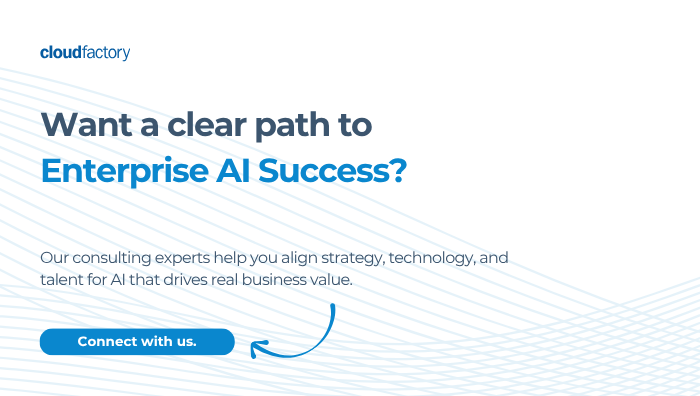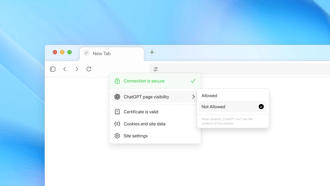Enterprise AI adoption has exploded from 6% to 30% in just a few short years, yet this rapid growth has exposed a critical vulnerability. While 82% of organizations have already deployed AI across business functions, most report persistent concerns about cost, trust, and governance. This creates a dangerous paradox: teams are scrambling to manage AI-related risks after implementation, leaving a perilous gap between AI policy and actual execution.
This isn't just a compliance issue—it's a strategic challenge that could determine which organizations thrive in the AI-driven economy and which get left behind.
Our Approach: Deep Understanding Drives Better Outcomes
At CloudFactory, we've learned that successful AI governance isn't about applying generic frameworks. It's about deepening corporate knowledge, understanding the legislative environment, and collaborating on use cases that address the subtle nuances in each business requirement to benefit our clients, their stakeholders, and their end customers.
Unbiased, and fair solutions form the foundation of trust of how we partner with each client. These principles guide how we vet potential use cases, select appropriate solutions, and assign roles to our team members. This approach has proven essential as we've worked across industries—delivering value-adding outcomes for mass-transit operators to pharmaceuticals to tax filing specialists.
While Machine Learning isn't a new concept, harnessing AI's full potential requires a disciplined approach. We achieve this through continuous trial-and-learning cycles that account for new model capabilities, digest lessons from academic and industry research, and incorporate insights from after-action reports of past projects.
The Regulatory Reality: Complex and Constantly Evolving
Whether developing tactical solutions for specific use cases or assisting clients in transforming end-to-end business processes, we evaluate existing legislation, corporate policies, and governance standards—then adopt these into our working methods to ensure conformance.
The regulatory landscape varies dramatically by context. For some clients, a single piece of legislation defines their approach. For others with multi-state or international operations, there's a complex patchwork of governing laws and rules to navigate.
Here's what we've observed across recent regulatory developments:
- U.S. federal agencies introduced 59 AI-related regulations in 2024—double the previous year
- The EU AI Act established the world's first comprehensive AI regulatory framework
- Global legislative mentions of AI rose 21.3% across 75 countries since 2023
- Countries from Brazil to Canada are drafting AI legislation following the "Brussels Effect"
How We Help: Regulatory Intelligence as a Service
Continuous monitoring is essential. We regularly scan for proposed legislation, formal guidance, and enforcement actions to determine what applies in the evolving landscape and where adaptations are necessary. This covers automated decision-making, profiling, data collection, data generation, and privacy requirements across state, federal, and international jurisdictions.
We stay ahead of shifting regulatory sentiment. Public opinion and regulatory guidance around AI evolve rapidly as policymakers, industry leaders, and experts continue debating issues like data localization and harm prevention. By monitoring these developments closely, we can proactively address client concerns and adapt our approach as needed.
We choose technology based on your needs, not vendor relationships. Rather than locking into specific AI providers, we evaluate each model's strengths and limitations for your particular use case. This vendor-agnostic approach ensures you get the best technical solution—whether that's the latest language model for content generation or a specialized tool for data analysis.
A Risk-Based Framework for Decision Making
The answer depends on your specific context. We've developed a practical framework for determining the appropriate governance approach:
Non-Regulated, Simple Use Cases
If your AI use aligns with corporate objectives and values, a lighter approach may suffice:
- Build on existing frameworks for information security and privacy rather than creating parallel structures
- Leverage free resources like those from Securiti Education for systematic governance self-evaluation
- Consider established standards such as ISO 42001 certification for AI management systems
- Document management decisions about AI use for stakeholder transparency
This approach works when stakeholders accept management-written statements about AI use and when building on pre-existing frameworks provides adequate coverage.
Regulated or Complex, Higher-Risk Use Cases
For clients in regulated sectors like healthcare, financial services, or construction—or use cases where AI makes determinations about customer or employee outcomes—consider these critical factors:
- Bias and fairness risks → How might your AI produce unintended discriminatory outcomes?
- Consequence mitigation → What safeguards prevent unjustified or harmful results?
- Independent validation → Will you need third-party certification to demonstrate compliance?
Recent legal cases demonstrate the real stakes involved. When organizations deploy AI systems that interact with customers or make decisions affecting people's rights, they remain legally responsible for the AI's outputs - even when those outputs conflict with internal policies or contain errors.
Technology Trends Shaping Governance Requirements
Recent developments indicate that AI governance has moved "beyond theoretical frameworks to tangible global action." Key trends include:
Automated compliance tools that monitor AI models and verify regulatory alignment in real-time are becoming standard practice.
Agentic AI systems capable of automating discrete tasks and workflows present new governance challenges as they begin replacing human employees in certain functions.
Risk-based approaches are emerging as the dominant regulatory paradigm, with stricter controls for high-risk applications like healthcare and recruitment.
Preparing for an Uncertain Future
The future isn't written, but we can reasonably expect laws and regulations to continue evolving in response to public sentiment and real-world incidents. Organizations partnering with vendors who can anticipate plausible regulatory paths and provide navigation guidance achieve AI benefits without the fear of non-compliant investments.
Success requires three key capabilities:
Systematic monitoring of regulatory developments across all relevant jurisdictions, not just headline-grabbing announcements.
Adaptive system design that accommodates new requirements through configuration rather than complete rebuilds.
Regular assumption testing because compliance requirements that were sufficient six months ago may not meet current standards.
Ready to Navigate AI Compliance Strategically?
Whether you're launching your first AI initiative or scaling existing deployments, the governance decisions you make today will determine your competitive position tomorrow. The window for establishing effective AI governance is narrowing as regulations become more specific and enforcement increases.
Want to explore how thoughtful governance can accelerate rather than constrain your AI objectives? We welcome the opportunity to discuss your specific use case and regulatory requirements in detail. Schedule a strategic consultation to review how our approach can help you achieve AI benefits without concerns about compliance.
Chris Shorthouse has deployed assurance programs across multiple industries and advised organizations on navigating complex regulatory environments. He specializes in helping businesses achieve compliance goals that support rather than hinder growth objectives.
.png?width=1563&height=1563&name=Untitled%20design%20(38).png)




.png?width=1563&height=1563&name=Untitled%20design%20(30).png)



.png?width=1563&height=1563&name=Untitled%20design%20(33).png)


.png?width=1563&height=1563&name=Untitled%20design%20(34).png)














